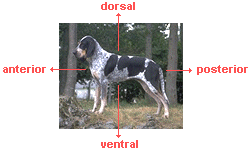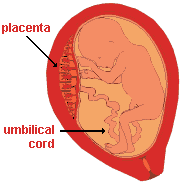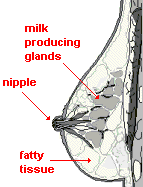Glossary of Terms
A B C D E F G H I J K L M N O P Q R S T U V W X Y Z
Select the first letter of the word you are seeking from the list above
to jump to the appropriate section of the glossary or scroll down to it
- A -
-
adaptive
radiation

- the relatively rapid expansion and diversification of an evolving group of organisms as they adapt to new ecological niches. Adaptive radiation is the process by which one species evolves into two or more species. This occurs as a result of different populations becoming reproductively isolated from each other, usually by adapting to different environments.
- amino acids

- organic molecules that are building blocks of proteins. There are at least 20 different kinds of amino acids in living things. Proteins are composed of different combinations of amino acids assembled in chain-like molecules. Amino acids are primarily composed of carbon, oxygen, hydrogen, and nitrogen.
-
amniote

- referring to an egg with a calcium carbonate rich, leather hard shell and protective membranes that prevent the embryo from rapidly drying out. Reptiles, birds, and prototherian mammals lay amniote eggs.
-
Amphibia

- the class of vertebrates that includes frogs, toads, and salamanders. Amphibians spend part of their lives under water and part on land. They must return to damp areas to reproduce since their eggs would otherwise dry out. They start life with gills, like fish, and later develop lungs to breath air.
-
anaerobic

- without oxygen
-
analogies

- anatomical features that have the same form or function in different species that have no known common ancestor. Analogies are also referred to as analogous structures or features.
-
analogous
structures

- see analogies.
-
Animalia

- the kingdom of living things that includes all animals. They are multicellular organisms that ingest food rather than absorb or photosynthesize it. They also have their own means of locomotion in at least one phase of their life cycles.
-
anterior

- see dorsal.
-
Arthropoda

- the animal phylum consisting of creatures that have external skeletons, and jointed bodies and limbs. Insects, spiders, lobsters, and crabs are arthropods.
-
Aves

- the class of vertebrates that includes all of the birds. Like reptiles, they lay amniote eggs.
Back to Top
- B -
- bilaterally
symmetrical

- the chordate characteristic of the left and right sides of the body being mirror images of each other. If there are two functionally similar body parts, they are usually found roughly equidistant from the center line, parallel to each other on bilaterally symmetrical animals.
-
binomen

- the Linnaean classification system use of two Latin name categories, genus and species, to designate each type of organism. A genus is a higher level category that includes one or more species under it. For example, humans are Homo sapiens, or "man who is wise"--Homo is our genus and sapiens is our species. Binomen literally means "two names" in Latin. Binomial nomenclature is another term for binomen.
-
binomial nomenclature

- see binomen.
Back to Top
- C -
-
Chondrichthyes

- the class of vertebrates that includes the fish that have skeletons consisting of cartilage rather than bone. These are the sharks and rays.
-
Chordata

- the phylum of animals that is characterized by elongated bilaterally symmetrical bodies. In some phase of their life cycle, they have a notochord and gill slits or pouches. Chordates also often have a head, a tail, and a digestive system with an opening at both ends of the body. The Chordata include fish, amphibians, reptiles, birds, mammals, and 2 invertebrate subphyla (tunicates and lancelets).
-
chordate

- a member of the phylum Chordata.
-
chromosomes

an approach to discovering evolutionary relationships between organisms based on shared derived traits. Cladistics has largely replaced the older approach known as evolutionary or phylogenetic sytematics which grouped organisms together based on homologies in general without distinguishing between primitive and derived ones.
- class
- the level of classification below subphylum and above subclass in the Linnaean classification system. Humans are members of the class Mammalia.
-
convergence

- the development of a similar anatomical feature in distinct species lines after divergence from a common ancestor that did not have the initial trait that led to it. The common ancestor is usually more distant in time than is the case with parallelism. Convergence is thought to be due primarily to the independent species lines experiencing the same kinds of natural selection pressures. Convergence is also referred to as convergent evolution. Convergence results in homoplasies.
- convergent evolution
- see convergence.
Back to Top
- D -
- derived trait (in regards to classifying organs)
- a biological trait that has changed over time from the ancestral form and/or function that was present in the species from which it came. See cladistics.
-
DNA
 (deoxyribonucleic acid
(deoxyribonucleic acid
 )
) - a large organic molecule that stores the genetic code for the synthesis of proteins. Each chromosome consists mostly of a DNA molecule. DNA is composed of sugars, phosphates and bases arranged in a double helix shaped molecular structure. Segments of DNA correspond to specific genes.
-
dorsal

- the biological sciences use the terms dorsal, ventral, anterior, and posterior to refer to direction within the body of a bilaterally symmetrical organism. These terms are illustrated in the photo on the right. Body parts on the sides of a body are referred to as being lateral. If something is along the longitudinal midline of a body, it is medial.
-
double helix

- the twisted ladder shape that is characteristic of DNA molecules.
Back to Top
- E -
-
ecological
niches

- specific micro-habitats in nature to which populations or organisms adapt. They are usually seen in terms of being food getting opportunities in the environment.
-
ectothermic

- the ability to maintain core body temperature in a normal range mainly by avoiding exposure to environmental temperature extremes. Reptiles, amphibians, fish, and insects are ectothermic animals. Ectothermy is also referred to as being cold blooded. See endothermic.
- embryo

- the earliest stage of development of an unborn child. In humans, the embryonic stage lasts up till about the 8th week of pregnancy. Following the embryonic stage, is the fetal stage.
- embryonic

- see embryo.
- endothermic

- the ability to maintain a relatively constant core body temperature regardless of external conditions by using internal physiological means. That is to say, they are homeothermic, or stable in core body temperature, as a result of endothermy. Birds and mammals are endothermic. Endothermy is also referred to as being warm blooded. See ectothermic.
- enzymes

- proteins that cause or regulate specific chemical reactions within cells.
-
Eutheria

- the infraclass of therian mammal species in which females produce a placenta to connect the fetus to the uterus. This enables nutrients and oxygen to get to the fetus and provides a means of eliminating waste products. As a result, eutherian mammals can carry their young within the uterus until late in fetal development. This has a selective advantage because it results in decreased infant mortality. Eutherian mammals are also called placental mammals. Included in this infraclass are dogs, cats, bears, whales, monkeys, humans, etc.
- evolution

- genetic change in a population of organisms that occurs over time. The term is also frequently used to refer to the appearance of a new species. More specifically, it is change in the frequencies of alleles in a population's gene pool from one generation to the next.
Back to Top
- F -
Back to Top
- G -
- genes

units of inheritance usually occurring at specific locations, or loci, on a chromosome. Physically, a gene is a sequence of DNA bases that specify the order of amino acids in a protein or, in some cases, a small RNA molecule referred to as a microRNA. A gene may be made up of hundreds to thousands of DNA bases. Genes are responsible for hereditary characteristics.
- genus
 (plural genera
(plural genera
 )
)
- a group of closely related species. In the Linnaean classification system, genus is the category immediately above species.
-
gestation

- the period between conception and birth during which an unborn young is within its mother's uterus. Pregnancy is another word for gestation.
-
gills

- breathing organs used to extract oxygen from water.
Back to Top
- H -
- heterodonts

- animals that have a variety of specialized teeth (incisors, canines, premolars, and molars). Mammals are heterodonts.
-
hierarchical

- an arrangement in terms of rank or importance. The Linnaean classification system of living things is hierarchical--it is a system of classification with the highest category consisting of all living things. Lower down are levels of less inclusive sub-categories. The lowest sub-category is a species.
-
homologies

- anatomical structures in different species that are similar due to descent from a common ancestor that had them. Homologies are also referred to as homologous structures or features. see cladistics.
- homologous
structures

- see homologies.
- homoplasies

- similar anatomical structures in different species that were not present in their common ancestor. Homoplasies are also referred to as homoplastic structures or features. Homoplasies can be due to parallelism, convergence, or even chance.
- homoplastic
structures

- see homoplasies.
- Homo sapiens

- the genus (Homo) and species (sapiens) categories to which modern humans belong.
Back to Top
- I -
-
invertebrate

- an animal that lacks an internal skeleton. All animals other than fish, amphibians, reptiles, birds, and mammals are invertebrates. Approximately 95% of all animals are invertebrates.
Back to Top
- J -
Back to Top
- K -
Back to Top
- L -
-
lancelets

- small, translucent fish-like marine animals without skeletons. They are classified as species in the phylum Chordata. The lancelet is also known as amphioxus.
-
- lateral

- see dorsal.
-
Linnaean

|
|
Back to Top
- M -
- macroscopic

- referring to objects that are large enough to be seen easily with the naked eye.
- mammal

- an animal in the class Mammalia.
-
Mammalia

- a class of warm blooded, usually hairy animals, that feed their young with milk secreted by the mammary glands of females. Mammalia include monotremes, marsupials, primates, cats, dogs, bears, hoofed animals, rodents, bats, seals, dolphins, and whales.
-
mammary glands

- milk secreting glands of mammals. They are usually located on the chest or abdomen in one or more bilaterally symmetrical pairs. Mammary glands are also referred to as breasts.
-
marsupials

- see Metatheria.
-
medial

- see dorsal.
-
Metatheria

- the infraclass of therian mammal species in which females bear their young in an immature condition (while still in the early fetal stage) and then permit their further infant development in an abdominal pouch covering their mammary glands. Compared to the delayed births of placental mammals, this is inefficient in keeping young infants alive. Metatherian mammals are also called marsupials. Included in this infraclass are kangaroos, koalas, opossums, etc.
-
Mollusca

- the animal phylum consisting of creatures that have soft unsegmented bodies that are usually, but not always, enclosed in a hard shell. They also usually have at least one strong foot that helps them move. Octopi, squids, clams, snails, and slugs are mollusks.
-
monotremes

- see Prototheria.
-
morphology

- the form and structure of an organism.
Back to Top
- N -
- natural selection
- an evolutionary mechanism that occurs when some individuals of a population are better able to adapt to their environment and, subsequently, produce more offspring. Nature, in effect, selects which members of a population are fit to survive long enough to reproduce. Differential productive success between individuals is the key. Those who produce more offspring have a greater influence on the gene frequencies of the next generation. This mechanism of evolutionary change was first articulated by Charles Darwin.
- niches
- see ecological niches.
-
notochord

- a rudimentary internal skeleton made of stiff cartilage that runs lengthwise under the dorsal surface of the body of chordates. Generally, there is a single hollow nerve chord on top of the notochord. Among humans and the other vertebrates, the notochord is replaced by a more complex skeleton following the embryonic stage of development.
Back to Top
- O -
- order
- a Linnaean classification category above the level of species and genus and below class. Each order can consist of many species and genera.
-
Osteichthyes

- the class of vertebrates that include the bony fish (e.g., trout, bass, tuna, etc.).
Back to Top
- P -
- parallel evolution
- see parallelism.
- parallelism

- a similar evolutionary development in different species lines after divergence from a common ancestor that had the initial anatomical feature that led to it. Parallelism is thought to be due primarily to the independent species lines experiencing the same kinds of natural selection pressures. Parallelism is also referred to as parallel evolution. Parallelism results in homoplasies. See convergence.
- pelvis

- the bones of the hip region. Also known as the pelvic girdle.
- photosynthesis

- the process by which green plants, algae, and some bacteria use energy from sun light to create new organic molecules (carbohydrates) and oxygen out of carbon dioxide, water, and elemental nutrients.
- phylum

- the level of classification just below kingdom in the Linnaean Classification system. At this level, animals are grouped together based on similarities in basic body plan or organization.
-
placental

- see Eutheria.
-
Plantae

- the kingdom of plants in the Linnaean Classification system. Members of this kingdom produce new cells out of inorganic material by photosynthesis. They do not have the ability to move around their environment except by growing or being transported by wind, water, or other external forces. The plant kingdom is also referred to as Planti.
-
posterior

- see dorsal.
- primitive trait (in regards to classifying organs)
- a biological trait that has not changed over time from the ancestral form and/or function that was present in the species from which it came. See cladistics.
-
prion

- a protein that has the ability to cause the cells that it invades to repeatedly duplicate it. Prions are responsible for causing Mad Cow Disease. Apparently, prions are not effectively attacked by their host's immune system nor can they be killed with existing antibiotics, extreme heat, cold, or other normally lethal conditions. The word prion comes from "proteinaceous infectious particle."
- proteins

- any of a large number of complex organic molecules that are composed of one or more chains of amino acids. Proteins can serve a wide variety of functions through their ability to bind to other molecules. Proteins may be enzymes, hormones, antibodies, structural components, or gas-transporting molecules.
-
Prototheria

- the subclass of mammal species in which females lay eggs like birds and reptiles. However, they feed their newborn with mammary gland secretions like all other mammals. The Prototheria are also referred to as monotremes, which literally means that they have only one opening for excretion and reproduction. Included in this subclass are the platypus and echidna.
Back to Top
- Q -
Back to Top
- R -
-
Reptilia

- the class of vertebrates that includes turtles, snakes, lizards, alligators, and other large reptiles. Like birds, they produce an amniote egg.
Back to Top
- S -
- species

- the largest natural population of organisms that can potentially interbreed to produce fertile offspring. It is commonly assumed that members of one species are reproductively isolated from members of all other species (i.e., they cannot mate with them to produce fertile offspring). However, we must be cautious in defining species with this criterion because members of very closely related species can sometimes produce offspring together, and a small fraction of those may be fertile to some degree. This is the case with mules, which are the product of mating between horses and donkeys. About one out of 10,000 mules is fertile. This suggests that some species differences are a matter of degree.
- subphyla

- the plural of subphylum (the level of classification immediately below phylum and above class in the Linnaean classification system).
Back to Top
- T -
- taxonomy

- naming, describing, and classifying organisms into different categories on the basis of their appearance and other diagnostic characteristics as well as their evolutionary relationships. The biological sciences primarily use the Linnaean classification system for this purpose.
-
Theria

- the subclass of mammal species that include the marsupials and placental mammals.
-
tunicates

- small, tube-like filter feeding
marine animals without skeletons. They are classified as being members of the animal
phylum Chordata.
The example shown on the right
is a yellow tunicate.
|
|
Back to Top
- U -
Back to Top
- V -
-
ventral

- see dorsal.
-
Vertebrata

- the subphylum of chordates that includes the animals that possess a spinal chord protected by a segmented vertebral column of cartilage and/or bone.
-
vertebrates

- members of the animal subphylum Vertebrata.
-
virus

- a category of extremely small microscopic parasites of plants, animals, and bacteria. Viruses are not cells but rather RNA or DNA molecules surrounded by a protein coating. Since viruses cannot reproduce without a host cell, they are not strictly speaking living organisms.
Back to Top
- W -
Back to Top
- X -
Back to Top
- Y -
Back to Top
- Z -
Back to Top
This page was last updated on
Monday, October 14, 2013.
Copyright © 1998-2013 by Dennis
O'Neil.
All rights reserved.
illustration
credits



